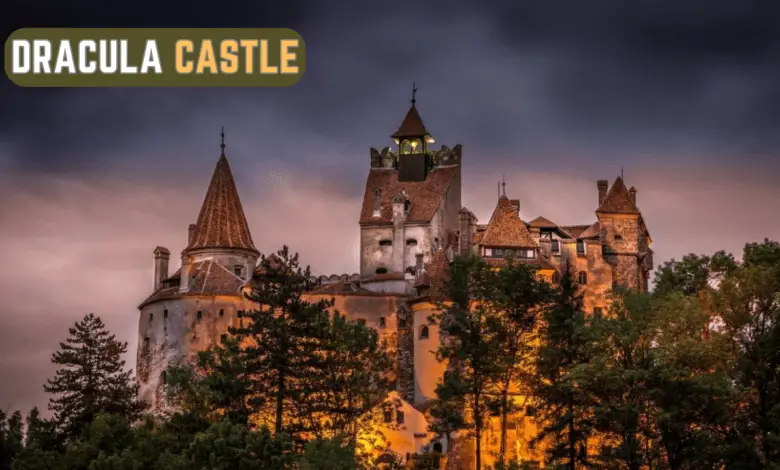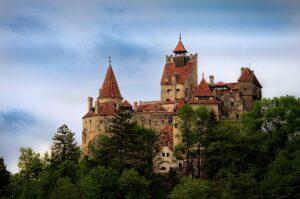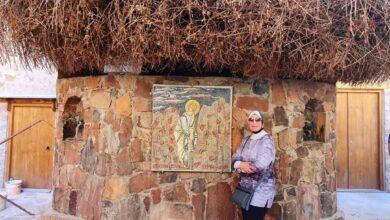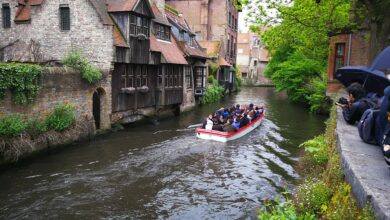🦇 The Legends and Lore of Transylvania: Discovering Dracula Castle 🏰
Unveiling the Mythical History Behind Bran Castle

Introduction
Transylvania, a land steeped in history and folklore, has captivated the imaginations of travelers, scholars, and thrill-seekers for centuries. It’s a place where fact and fiction intertwine, where the boundaries between reality and legend blur. At the heart of Transylvania’s mystique lies the infamous Dracula’s Castle, a place that has inspired countless tales of vampires, bloodlust, and the supernatural.
In this blog post, we embark on a journey through the legends and lore of Transylvania, with a particular focus on discovering the secrets of Dracula’s Castle. We’ll delve into the historical context, the myths that surround it, and its modern-day significance. Whether you’re an avid history enthusiast, a fan of vampire lore, or simply a curious traveler, join us as we unravel the enigmatic story of Bran Castle and the enduring fascination with the legendary Dracula.
The Historical Context
1. Transylvania: A land of diverse cultures and histories
Transylvania, a region in central Romania, is a land steeped in rich cultural and historical diversity. Its history is a tapestry woven from the threads of various civilizations, making it a captivating destination for history enthusiasts and travelers alike.
The story of Transylvania begins with its ancient roots, dating back to the Dacian tribes that inhabited the region before the Roman conquest. The Romans left their mark, evident in the ruins of their fortifications and roads that still dot the landscape today. Following the fall of the Roman Empire, Transylvania became a crossroads for various migrating peoples, including the Huns, Visigoths, and Lombards.
One of the most significant chapters in Transylvania’s history is its association with the Hungarian Kingdom, which lasted for nearly a thousand years. During this time, the region experienced cultural assimilation and religious diversity, with Hungarian, Saxon, and Romanian communities coexisting and contributing to its unique heritage.
In the late Middle Ages, Transylvania played a crucial role in the struggle between the Ottoman Empire and the Christian kingdoms of Europe. It was during this time that Vlad the Impaler, a figure shrouded in both fact and fiction, emerged as a prominent historical character.
Today, Transylvania is a land where these diverse influences are still visible in its architecture, cuisine, and traditions. Visitors can explore medieval castles, such as Bran Castle, and wander through picturesque villages that seem frozen in time. Transylvania’s cultural mosaic continues to fascinate, inviting travelers to delve into its captivating past and experience its vibrant present.
2. Vlad the Impaler: Separating fact from fiction
Vlad the Impaler, also known as Vlad III or Vlad Dracula, is a historical figure who has become the stuff of legends and vampire lore. While the line between fact and fiction has blurred over the centuries, separating the real Vlad from the fictional Dracula is essential to understanding Transylvania’s history.
Vlad III ruled over the principality of Wallachia, not Transylvania, in the 15th century. His nickname, “the Impaler,” was earned due to his brutal method of executing enemies by impaling them on wooden stakes. Although his methods were undeniably cruel, Vlad is also celebrated by some as a defender of Wallachia against Ottoman invasion.
The association between Vlad and Bran Castle, often referred to as “Dracula’s Castle,” is more fiction than fact. While Vlad may have briefly stayed at the castle, it was not a central part of his life or reign. In reality, Bran Castle served as a fortress guarding a mountain pass and played a strategic role in the defense of Transylvania.
Vlad’s legacy is a complex one, with conflicting accounts of his rule. Some view him as a ruthless tyrant, while others consider him a national hero. Regardless of one’s perspective, Vlad the Impaler’s historical significance cannot be denied, and his story continues to captivate those who seek to uncover the truth behind the legend.
3. The construction of Bran Castle
Bran Castle, often associated with the Dracula legend, has a fascinating history of its own. Located near the town of Bran in Transylvania, this imposing fortress was not originally built as a vampire’s lair but rather served strategic military purposes.
Construction of Bran Castle began in the 14th century, during a time when Transylvania (read more about Transylvania on Wikipedia) was part of the Hungarian Kingdom. Its primary function was to guard the strategically important mountain pass against invading forces and to collect tolls from merchants passing through the region. The castle’s location at the crossroads of trade routes made it a key stronghold.
Over the centuries, Bran Castle underwent several architectural modifications, transforming it from a military fortress into a royal residence. It played a crucial role in defending Transylvania against various threats, including Ottoman incursions. Notably, it served as a customs post during the 1920s.

Bran Castle: Dracula’s Fortress
-
Architectural features and significance
Bran Castle, often referred to as “Dracula’s Fortress,” is a striking architectural gem nestled in the heart of Transylvania, Romania. Its unique design and historical significance make it a captivating destination for history enthusiasts and travelers alike.
The castle is a stunning example of Gothic architecture, characterized by its imposing towers, high walls, and picturesque location atop a hill. It boasts a labyrinthine layout, with narrow staircases, secret passages, and rooms that seem to have been plucked from the pages of a medieval fairy tale. The castle’s stone walls are punctuated with arrow slits and battlements, a testament to its original purpose as a military fortress.
Constructed in the 14th century, Bran Castle served as a strategic stronghold, guarding the mountain pass leading into Transylvania. Its location made it an essential part of the region’s defense against invading forces. Over the centuries, the castle underwent various architectural modifications, transforming it from a military bastion into a royal residence.
Today, visitors can explore its well-preserved rooms and corridors, which offer a glimpse into medieval life in Transylvania. The castle also houses a museum showcasing art and furniture collections, providing further insight into its historical and cultural significance. Its architectural splendor and role in Transylvanian history make Bran Castle a must-visit attraction in the region.
-
The connection between Bran Castle and Bram Stoker’s Dracula
Bran Castle’s association with Bram Stoker’s iconic vampire character, Dracula, has contributed to its worldwide fame. However, it’s essential to clarify that this connection is more a product of literary imagination than historical reality.
Bram Stoker’s novel, “Dracula,” published in 1897, introduced the world to the enigmatic and seductive Count Dracula, a vampire from Transylvania. While Stoker’s work was inspired by various sources, including Eastern European folklore and legends, he never visited Bran Castle. Instead, he drew inspiration from descriptions of other Transylvanian castles and landscapes.
The connection between Bran Castle and Dracula was largely popularized by tourism and the allure of marketing. In the 20th century, the castle’s Gothic appearance, location in Transylvania, and the ambiguity of its historical ties to Vlad the Impaler led to the widespread belief that it was Dracula’s residence. This association, although based on fiction, has made Bran Castle an iconic destination for Dracula enthusiasts and fans of the Gothic horror genre.
While Bran Castle may not have direct historical links to the fictional Dracula, its captivating ambiance and mysterious aura continue to attract visitors eager to explore the legends and lore of this famous fortress.
-
The castle’s role in Transylvanian history
Beyond its association with Dracula, Bran Castle has played a significant role in the history of Transylvania. Built in the 14th century, it served as a crucial military stronghold and customs post, strategically positioned to control trade routes and protect the region from potential invaders.
Throughout its history, the castle witnessed various historical events and conflicts. It played a part in defending Transylvania against Ottoman invasions during the 15th century. Later, it served as a royal residence and was instrumental in the consolidation of the Austro-Hungarian Empire’s influence in the region.
Bran Castle’s importance in Transylvanian history is not confined to military and political roles; it also reflects the cultural and architectural evolution of the region. Its transformation from a fortress to a royal residence showcases the adaptability of architectural styles over the centuries.
Legends and Myths
→ Dracula: From history to legend
The transformation of Vlad the Impaler, a 15th-century ruler of Wallachia, into the infamous Dracula is a journey from historical fact to the realm of legend and fiction. While Vlad III’s life was marked by brutality and a fierce defense of his realm, it is the blending of his history with the Gothic imagination of Bram Stoker that gave birth to the enduring legend of Dracula.
Vlad III, also known as Vlad Dracula, ruled Wallachia in the mid-15th century. His nickname “the Impaler” was earned due to his gruesome method of executing enemies by impaling them on stakes. While his rule was undoubtedly brutal, it was primarily a response to the chaotic political landscape of the time, where survival often depended on extreme measures.
The transformation of Vlad into Dracula began with Bram Stoker’s 1897 novel of the same name. Stoker drew inspiration from various sources, including Eastern European folklore, but Vlad’s historical brutality and the aura of Transylvania provided the perfect backdrop for his fictional vampire tale. Stoker’s Dracula, a seductive and immortal vampire, bore little resemblance to the real Vlad, but the connection between the two became a cornerstone of vampire lore.
Today, Dracula stands as one of the most iconic and enduring figures in literature and popular culture, a testament to the power of blending history with myth. The historical Vlad may have been a ruthless ruler, but the legend of Dracula has captured the world’s imagination, forever linking him to Transylvania and the realm of the supernatural.
→ The allure of vampire folklore
Vampire folklore has held a mesmerizing allure for centuries, transcending cultural boundaries and captivating the human psyche. The fascination with vampires can be attributed to several factors, including their mysterious and immortal nature, their seductive and menacing qualities, and the exploration of timeless themes in folklore.
Vampires are often portrayed as immortal beings who feed on the life essence of the living, typically through the act of bloodsucking. This notion of immortality and the fear of death have deep psychological roots in human culture. Vampires challenge our understanding of mortality and the boundary between life and death.
Furthermore, vampire folklore often delves into themes of desire and temptation. The vampire’s ability to seduce its victims, usually depicted as a charismatic figure, explores the complex interplay of attraction and danger. This element of forbidden allure has been a recurring motif in vampire stories, adding layers of intrigue and complexity to the folklore.
Vampire legends also frequently reflect societal fears and anxieties of their respective eras. From the folklore of Eastern Europe to the Gothic novels of the 19th century and contemporary vampire-themed literature and cinema, these mythical creatures continue to evolve and adapt to reflect the concerns and desires of their times.
The enduring fascination with vampire folklore is a testament to its ability to tap into universal human emotions and concerns, providing a lens through which we can explore the darker aspects of human nature and our collective imagination.
→ Famous vampire legends associated with Transylvania
Transylvania, with its eerie landscapes and Gothic architecture, has long been a fertile ground for vampire legends and stories. While Dracula is undoubtedly the most famous, there are other vampire tales and myths that have emerged from this mysterious region.
- Nosferatu: The silent film “Nosferatu” (1922) introduced the world to Count Orlok, a vampire inspired by Dracula but with a distinct and eerie appearance. This cinematic classic added a unique twist to the vampire legend and remains influential in vampire lore.
- Strigoi: In Romanian folklore, the strigoi are malevolent spirits that can transform into vampires. They are believed to return from the dead to harm the living. These legends have deep roots in Transylvania’s cultural history.
- Varcolac: The varcolac is another creature from Romanian folklore often associated with werewolves. However, in some versions of the legend, it can also possess vampiric qualities, adding complexity to the region’s supernatural lore.
- The Moroi: Moroi are restless spirits or vampires in Romanian mythology. They are often depicted as the spirits of deceased individuals who return to torment the living.
These vampire legends, alongside the iconic Dracula, contribute to the aura of mystique and intrigue that surrounds Transylvania. The region’s dark forests, medieval castles, and folklore have made it a captivating setting for vampire stories that continue to enthrall audiences worldwide.
The Modern Legacy
→ Bran Castle today: A museum and cultural landmark
Bran Castle, often associated with Dracula, has evolved into a prominent museum and cultural landmark in modern times. While its historical connections to Vlad the Impaler and Bram Stoker’s fictional Dracula may be tenuous, the castle’s significance in preserving Transylvanian heritage is undeniable.
Today, Bran Castle serves as a museum that offers visitors a multifaceted experience. Its well-preserved rooms and corridors showcase the castle’s history, from its medieval military origins to its transformation into a royal residence. Visitors can explore art and furniture collections that provide insights into the region’s past.
As a cultural landmark, Bran Castle plays a vital role in promoting and preserving Transylvanian history and culture. Its picturesque location in the Carpathian Mountains attracts tourists from around the world, contributing to the local economy and promoting tourism in the region. The castle’s rich history and architectural beauty make it a symbol of Transylvania’s heritage, ensuring that future generations can connect with the region’s past.
→ Pop culture references and Dracula’s enduring influence
The enduring influence of Dracula on popular culture is a testament to the timeless appeal of the vampire legend. Bram Stoker’s creation has inspired countless books, films, television series, and other forms of media, shaping the way we perceive vampires and the Gothic genre.
Dracula has been portrayed in various adaptations, from Bela Lugosi’s iconic performance in the 1931 film to modern interpretations like the TV series “Dracula.” These adaptations have contributed to the character’s enduring popularity and have introduced new generations to the world of vampires.
Beyond literature and cinema, Dracula has left its mark on music, fashion, and even tourism. Gothic and vampire subcultures have emerged, with enthusiasts immersing themselves in the aesthetics and themes associated with the Dracula legend. The character’s image, with his cape and fangs, has become synonymous with Halloween and the horror genre.
The legacy of Dracula is a testament to the power of storytelling to shape our cultural imagination. Its enduring influence continues to captivate and entertain audiences, ensuring that the vampire legend will remain a part of our cultural landscape for generations to come.
→ The importance of preserving Transylvanian folklore
Transylvanian folklore, which includes vampire legends like Dracula and other supernatural tales, holds a unique place in the region’s cultural identity. Preserving this folklore is essential for several reasons.
Firstly, folklore provides a window into the history, beliefs, and traditions of a particular culture or region. Transylvanian folklore reflects the complex interplay of different cultures and influences that have shaped the region over centuries. By preserving these stories and legends, we can better understand Transylvania’s rich and diverse heritage.
Secondly, folklore is a source of cultural pride and identity. It connects people to their roots and allows them to celebrate their unique traditions. In Transylvania, folklore festivals and events showcase the region’s customs, music, dance, and storytelling, keeping these traditions alive for future generations.
Lastly, folklore is a source of inspiration for art, literature, and tourism. The legends of Transylvania, including those of vampires and other supernatural beings, have captured the imaginations of artists, writers, and travelers. Preserving this folklore not only enriches cultural expressions but also contributes to the region’s economy through cultural tourism.
FAQs
Q: Is Dracula’s Castle a real place?
A: Yes, Dracula’s Castle, also known as Bran Castle, is a real historical fortress located in Transylvania, Romania.
Q: Did Vlad the Impaler, the inspiration for Count Dracula, live in Bran Castle?
A: No, Vlad the Impaler did not live in Bran Castle, but it is associated with the Dracula legend due to its proximity to his domain.
Q: Are there guided tours available at Bran Castle?
A: Yes, Bran Castle offers guided tours that provide visitors with insights into its history and legends.
Q: What is the best time to visit Transylvania?
A: The best time to visit Transylvania is during the spring and summer months when the weather is pleasant, and the landscapes are lush and beautiful.
Q: Are there other attractions to explore in Transylvania?
A: Yes, Transylvania is home to numerous attractions, including medieval towns, fortified churches, and stunning natural landscapes.
Q: Can I explore the Dracula legend further in Transylvania?
A: Absolutely! Transylvania offers various opportunities to delve deeper into the Dracula legend, including themed tours and events.
Conclusion
As we conclude our exploration of Transylvania’s rich history and the enduring allure of Dracula’s Castle, one thing becomes abundantly clear: this land is a place where fact and fiction dance together, creating an atmosphere of mystery and wonder. Whether you come for the historical significance, the allure of vampire legends, or the sheer beauty of the region, Transylvania offers a tapestry of experiences that few places can match.
While the myths of Dracula and his castle may be the stuff of legend, the very real history and culture of Transylvania are equally enchanting. As you plan your own journey to this captivating region, keep an open mind and a curious spirit, for it is in the exploration of both fact and fantasy that the true magic of Transylvania is revealed. So, whether you seek to uncover the secrets of Bran Castle or simply bask in the beauty of the Carpathian Mountains, Transylvania awaits, ready to weave its spell upon your heart.
Up Next
🏡 The Enchanting Villas of Tuscany: A Stay in the Italian Countryside 🌿





Facebook Comments